Case Study: Nestle's Strategic HRM and Talent Acquisition Analysis
VerifiedAdded on 2022/08/18
|11
|4377
|113
Case Study
AI Summary
This case study provides an overview of Nestle's human resource management (HRM) practices, emphasizing the company's strategic approach to talent acquisition, training, and employee development. It begins with an environmental analysis, including PESTEL and SWOT frameworks, to understand the external and internal factors influencing Nestle's operations. The study highlights Nestle's reliance on human resources as a key source of success, focusing on high performance, high commitment, and high involvement models. It also examines the company's talent acquisition process, which prioritizes alignment with organizational values, and its comprehensive training and learning programs aimed at bridging performance gaps and fostering continuous improvement. The case study further discusses Nestle's commitment to creating a positive working environment and its efforts to enhance employee satisfaction and engagement, ultimately contributing to the company's competitive position and long-term competence in the global food processing industry. The Jackson and Schuler framework is used to link internal and external factors in the context of HRM.
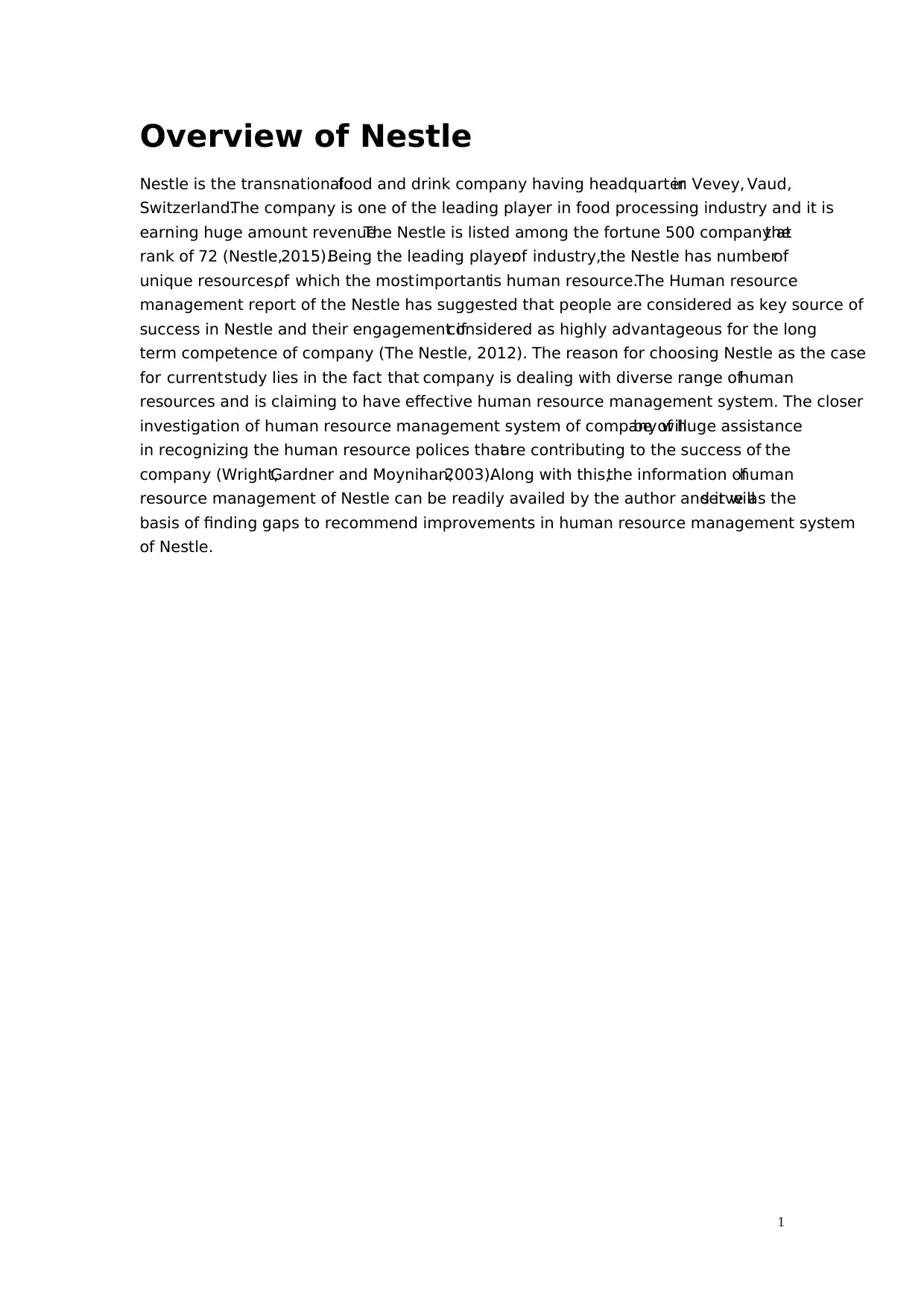
1
Overview of Nestle
Nestle is the transnationalfood and drink company having headquarterin Vevey, Vaud,
Switzerland.The company is one of the leading player in food processing industry and it is
earning huge amount revenue.The Nestle is listed among the fortune 500 company atthe
rank of 72 (Nestle,2015).Being the leading playerof industry,the Nestle has numberof
unique resources,of which the mostimportantis human resource.The Human resource
management report of the Nestle has suggested that people are considered as key source of
success in Nestle and their engagement ifconsidered as highly advantageous for the long
term competence of company (The Nestle, 2012). The reason for choosing Nestle as the case
for currentstudy lies in the fact that company is dealing with diverse range ofhuman
resources and is claiming to have effective human resource management system. The closer
investigation of human resource management system of company willbe of huge assistance
in recognizing the human resource polices thatare contributing to the success of the
company (Wright,Gardner and Moynihan,2003).Along with this,the information ofhuman
resource management of Nestle can be readily availed by the author and it willserve as the
basis of finding gaps to recommend improvements in human resource management system
of Nestle.
Overview of Nestle
Nestle is the transnationalfood and drink company having headquarterin Vevey, Vaud,
Switzerland.The company is one of the leading player in food processing industry and it is
earning huge amount revenue.The Nestle is listed among the fortune 500 company atthe
rank of 72 (Nestle,2015).Being the leading playerof industry,the Nestle has numberof
unique resources,of which the mostimportantis human resource.The Human resource
management report of the Nestle has suggested that people are considered as key source of
success in Nestle and their engagement ifconsidered as highly advantageous for the long
term competence of company (The Nestle, 2012). The reason for choosing Nestle as the case
for currentstudy lies in the fact that company is dealing with diverse range ofhuman
resources and is claiming to have effective human resource management system. The closer
investigation of human resource management system of company willbe of huge assistance
in recognizing the human resource polices thatare contributing to the success of the
company (Wright,Gardner and Moynihan,2003).Along with this,the information ofhuman
resource management of Nestle can be readily availed by the author and it willserve as the
basis of finding gaps to recommend improvements in human resource management system
of Nestle.
Paraphrase This Document
Need a fresh take? Get an instant paraphrase of this document with our AI Paraphraser
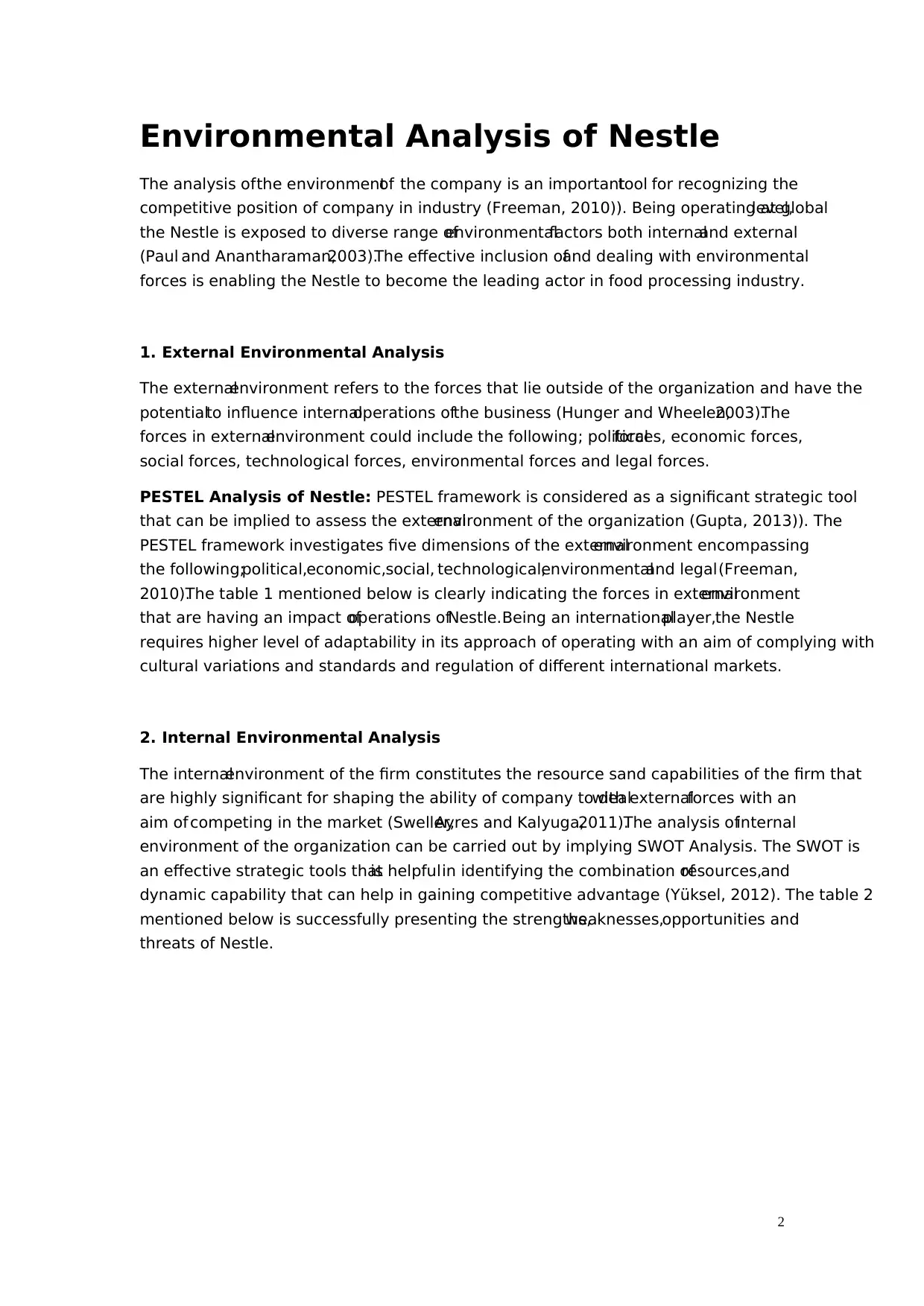
2
Environmental Analysis of Nestle
The analysis ofthe environmentof the company is an importanttool for recognizing the
competitive position of company in industry (Freeman, 2010)). Being operating at globallevel,
the Nestle is exposed to diverse range ofenvironmentalfactors both internaland external
(Paul and Anantharaman,2003).The effective inclusion ofand dealing with environmental
forces is enabling the Nestle to become the leading actor in food processing industry.
1. External Environmental Analysis
The externalenvironment refers to the forces that lie outside of the organization and have the
potentialto influence internaloperations ofthe business (Hunger and Wheelen,2003).The
forces in externalenvironment could include the following; politicalforces, economic forces,
social forces, technological forces, environmental forces and legal forces.
PESTEL Analysis of Nestle: PESTEL framework is considered as a significant strategic tool
that can be implied to assess the externalenvironment of the organization (Gupta, 2013)). The
PESTEL framework investigates five dimensions of the externalenvironment encompassing
the following;political,economic,social, technological,environmentaland legal(Freeman,
2010).The table 1 mentioned below is clearly indicating the forces in externalenvironment
that are having an impact ofoperations ofNestle.Being an internationalplayer,the Nestle
requires higher level of adaptability in its approach of operating with an aim of complying with
cultural variations and standards and regulation of different international markets.
2. Internal Environmental Analysis
The internalenvironment of the firm constitutes the resource sand capabilities of the firm that
are highly significant for shaping the ability of company to dealwith externalforces with an
aim of competing in the market (Sweller,Ayres and Kalyuga,2011).The analysis ofinternal
environment of the organization can be carried out by implying SWOT Analysis. The SWOT is
an effective strategic tools thatis helpfulin identifying the combination ofresources,and
dynamic capability that can help in gaining competitive advantage (Yüksel, 2012). The table 2
mentioned below is successfully presenting the strengths,weaknesses,opportunities and
threats of Nestle.
Environmental Analysis of Nestle
The analysis ofthe environmentof the company is an importanttool for recognizing the
competitive position of company in industry (Freeman, 2010)). Being operating at globallevel,
the Nestle is exposed to diverse range ofenvironmentalfactors both internaland external
(Paul and Anantharaman,2003).The effective inclusion ofand dealing with environmental
forces is enabling the Nestle to become the leading actor in food processing industry.
1. External Environmental Analysis
The externalenvironment refers to the forces that lie outside of the organization and have the
potentialto influence internaloperations ofthe business (Hunger and Wheelen,2003).The
forces in externalenvironment could include the following; politicalforces, economic forces,
social forces, technological forces, environmental forces and legal forces.
PESTEL Analysis of Nestle: PESTEL framework is considered as a significant strategic tool
that can be implied to assess the externalenvironment of the organization (Gupta, 2013)). The
PESTEL framework investigates five dimensions of the externalenvironment encompassing
the following;political,economic,social, technological,environmentaland legal(Freeman,
2010).The table 1 mentioned below is clearly indicating the forces in externalenvironment
that are having an impact ofoperations ofNestle.Being an internationalplayer,the Nestle
requires higher level of adaptability in its approach of operating with an aim of complying with
cultural variations and standards and regulation of different international markets.
2. Internal Environmental Analysis
The internalenvironment of the firm constitutes the resource sand capabilities of the firm that
are highly significant for shaping the ability of company to dealwith externalforces with an
aim of competing in the market (Sweller,Ayres and Kalyuga,2011).The analysis ofinternal
environment of the organization can be carried out by implying SWOT Analysis. The SWOT is
an effective strategic tools thatis helpfulin identifying the combination ofresources,and
dynamic capability that can help in gaining competitive advantage (Yüksel, 2012). The table 2
mentioned below is successfully presenting the strengths,weaknesses,opportunities and
threats of Nestle.
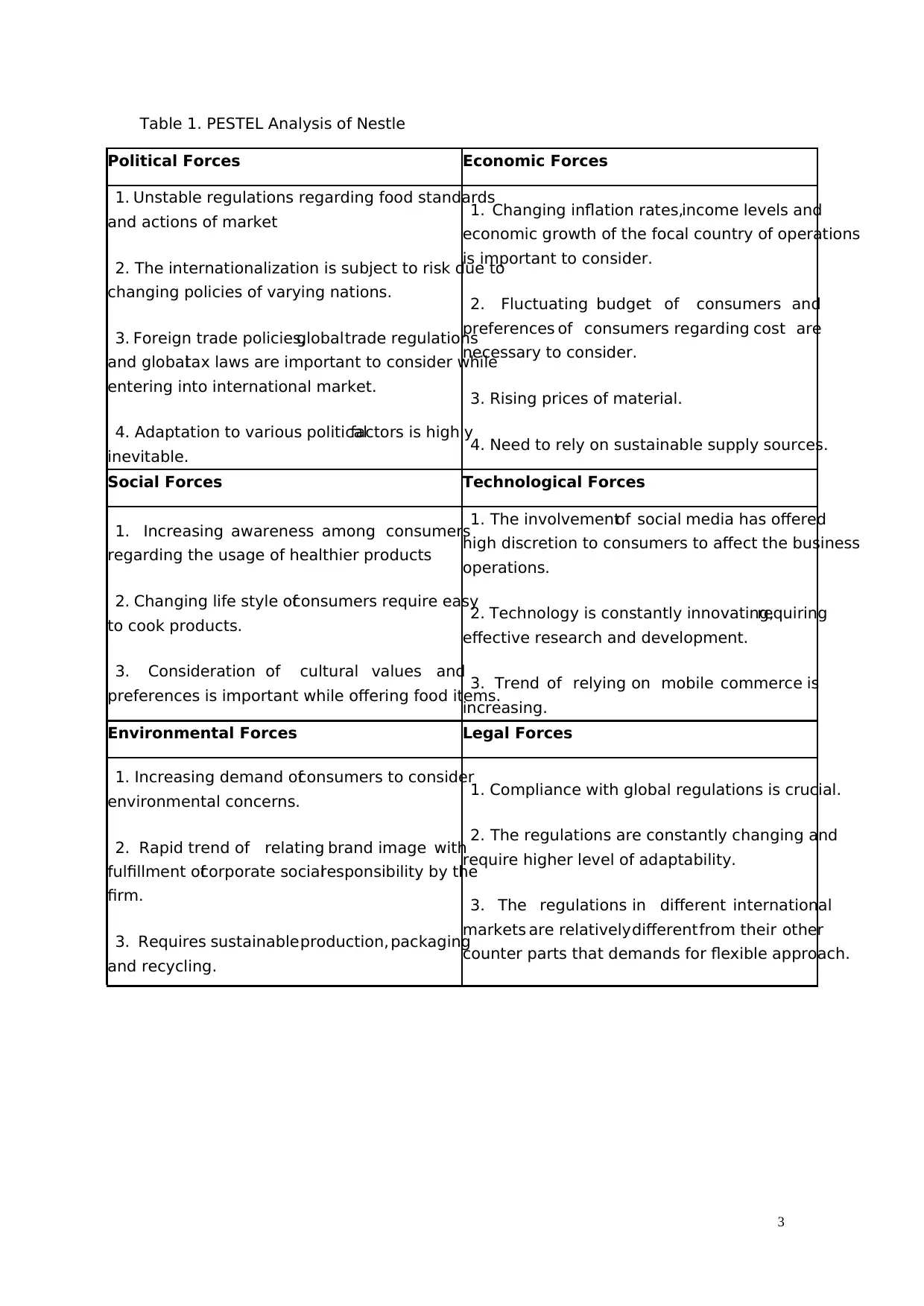
3
Table 1. PESTEL Analysis of Nestle
Political Forces Economic Forces
1. Unstable regulations regarding food standards
and actions of market
2. The internationalization is subject to risk due to
changing policies of varying nations.
3. Foreign trade policies,globaltrade regulations
and globaltax laws are important to consider while
entering into international market.
4. Adaptation to various politicalfactors is highly
inevitable.
1. Changing inflation rates,income levels and
economic growth of the focal country of operations
is important to consider.
2. Fluctuating budget of consumers and
preferences of consumers regarding cost are
necessary to consider.
3. Rising prices of material.
4. Need to rely on sustainable supply sources.
Social Forces Technological Forces
1. Increasing awareness among consumers
regarding the usage of healthier products
2. Changing life style ofconsumers require easy
to cook products.
3. Consideration of cultural values and
preferences is important while offering food items.
1. The involvementof social media has offered
high discretion to consumers to affect the business
operations.
2. Technology is constantly innovating,requiring
effective research and development.
3. Trend of relying on mobile commerce is
increasing.
Environmental Forces Legal Forces
1. Increasing demand ofconsumers to consider
environmental concerns.
2. Rapid trend of relating brand image with
fulfillment ofcorporate socialresponsibility by the
firm.
3. Requires sustainableproduction, packaging
and recycling.
1. Compliance with global regulations is crucial.
2. The regulations are constantly changing and
require higher level of adaptability.
3. The regulations in different international
markets are relativelydifferentfrom their other
counter parts that demands for flexible approach.
Table 1. PESTEL Analysis of Nestle
Political Forces Economic Forces
1. Unstable regulations regarding food standards
and actions of market
2. The internationalization is subject to risk due to
changing policies of varying nations.
3. Foreign trade policies,globaltrade regulations
and globaltax laws are important to consider while
entering into international market.
4. Adaptation to various politicalfactors is highly
inevitable.
1. Changing inflation rates,income levels and
economic growth of the focal country of operations
is important to consider.
2. Fluctuating budget of consumers and
preferences of consumers regarding cost are
necessary to consider.
3. Rising prices of material.
4. Need to rely on sustainable supply sources.
Social Forces Technological Forces
1. Increasing awareness among consumers
regarding the usage of healthier products
2. Changing life style ofconsumers require easy
to cook products.
3. Consideration of cultural values and
preferences is important while offering food items.
1. The involvementof social media has offered
high discretion to consumers to affect the business
operations.
2. Technology is constantly innovating,requiring
effective research and development.
3. Trend of relying on mobile commerce is
increasing.
Environmental Forces Legal Forces
1. Increasing demand ofconsumers to consider
environmental concerns.
2. Rapid trend of relating brand image with
fulfillment ofcorporate socialresponsibility by the
firm.
3. Requires sustainableproduction, packaging
and recycling.
1. Compliance with global regulations is crucial.
2. The regulations are constantly changing and
require higher level of adaptability.
3. The regulations in different international
markets are relativelydifferentfrom their other
counter parts that demands for flexible approach.
⊘ This is a preview!⊘
Do you want full access?
Subscribe today to unlock all pages.

Trusted by 1+ million students worldwide
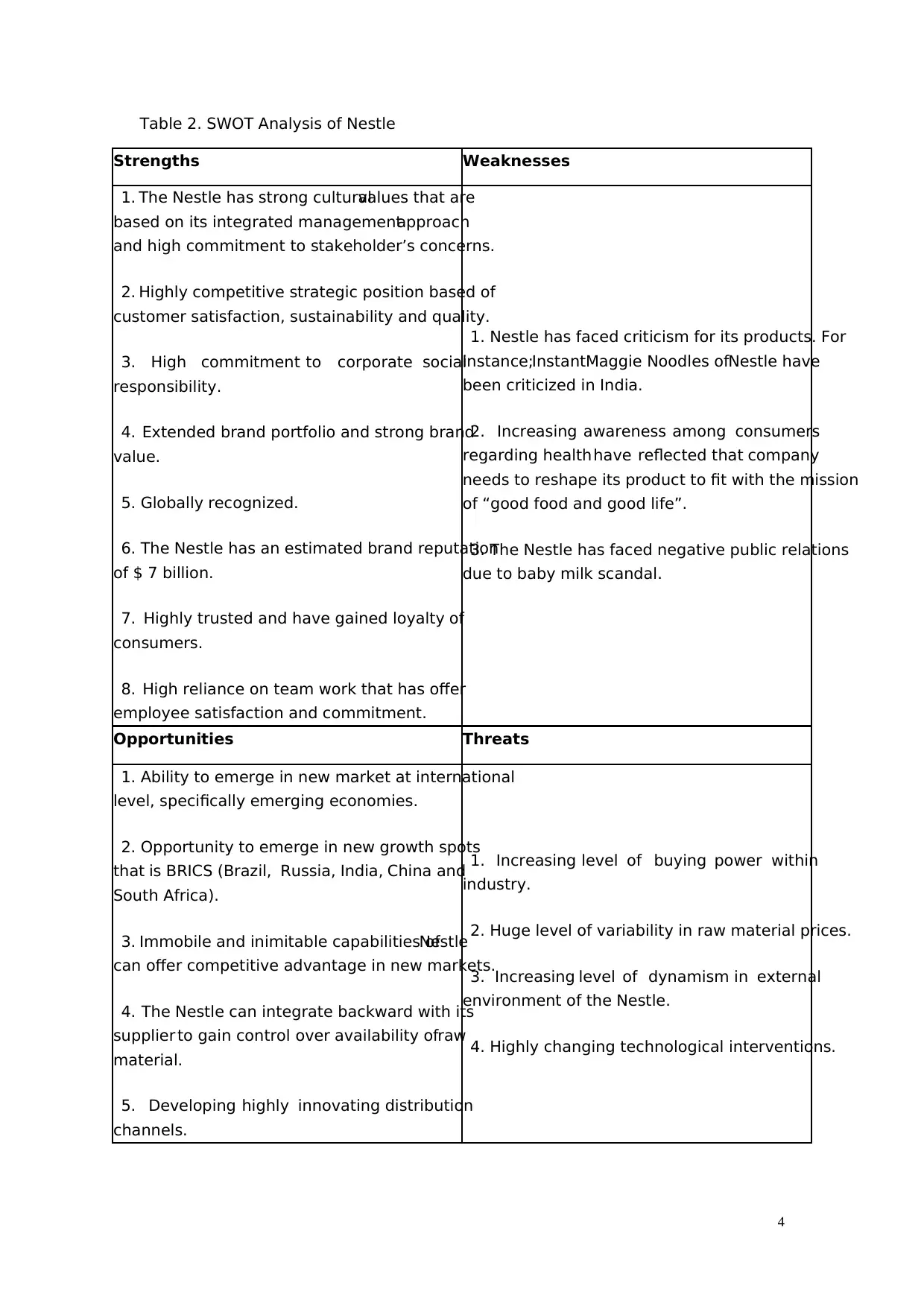
4
Table 2. SWOT Analysis of Nestle
Strengths Weaknesses
1. The Nestle has strong culturalvalues that are
based on its integrated managementapproach
and high commitment to stakeholder’s concerns.
2. Highly competitive strategic position based of
customer satisfaction, sustainability and quality.
3. High commitment to corporate social
responsibility.
4. Extended brand portfolio and strong brand
value.
5. Globally recognized.
6. The Nestle has an estimated brand reputation
of $ 7 billion.
7. Highly trusted and have gained loyalty of
consumers.
8. High reliance on team work that has offer
employee satisfaction and commitment.
1. Nestle has faced criticism for its products. For
instance;InstantMaggie Noodles ofNestle have
been criticized in India.
2. Increasing awareness among consumers
regarding healthhave reflected that company
needs to reshape its product to fit with the mission
of “good food and good life”.
3. The Nestle has faced negative public relations
due to baby milk scandal.
Opportunities Threats
1. Ability to emerge in new market at international
level, specifically emerging economies.
2. Opportunity to emerge in new growth spots
that is BRICS (Brazil, Russia, India, China and
South Africa).
3. Immobile and inimitable capabilities ofNestle
can offer competitive advantage in new markets.
4. The Nestle can integrate backward with its
supplier to gain control over availability ofraw
material.
5. Developing highly innovating distribution
channels.
1. Increasing level of buying power within
industry.
2. Huge level of variability in raw material prices.
3. Increasing level of dynamism in external
environment of the Nestle.
4. Highly changing technological interventions.
Table 2. SWOT Analysis of Nestle
Strengths Weaknesses
1. The Nestle has strong culturalvalues that are
based on its integrated managementapproach
and high commitment to stakeholder’s concerns.
2. Highly competitive strategic position based of
customer satisfaction, sustainability and quality.
3. High commitment to corporate social
responsibility.
4. Extended brand portfolio and strong brand
value.
5. Globally recognized.
6. The Nestle has an estimated brand reputation
of $ 7 billion.
7. Highly trusted and have gained loyalty of
consumers.
8. High reliance on team work that has offer
employee satisfaction and commitment.
1. Nestle has faced criticism for its products. For
instance;InstantMaggie Noodles ofNestle have
been criticized in India.
2. Increasing awareness among consumers
regarding healthhave reflected that company
needs to reshape its product to fit with the mission
of “good food and good life”.
3. The Nestle has faced negative public relations
due to baby milk scandal.
Opportunities Threats
1. Ability to emerge in new market at international
level, specifically emerging economies.
2. Opportunity to emerge in new growth spots
that is BRICS (Brazil, Russia, India, China and
South Africa).
3. Immobile and inimitable capabilities ofNestle
can offer competitive advantage in new markets.
4. The Nestle can integrate backward with its
supplier to gain control over availability ofraw
material.
5. Developing highly innovating distribution
channels.
1. Increasing level of buying power within
industry.
2. Huge level of variability in raw material prices.
3. Increasing level of dynamism in external
environment of the Nestle.
4. Highly changing technological interventions.
Paraphrase This Document
Need a fresh take? Get an instant paraphrase of this document with our AI Paraphraser
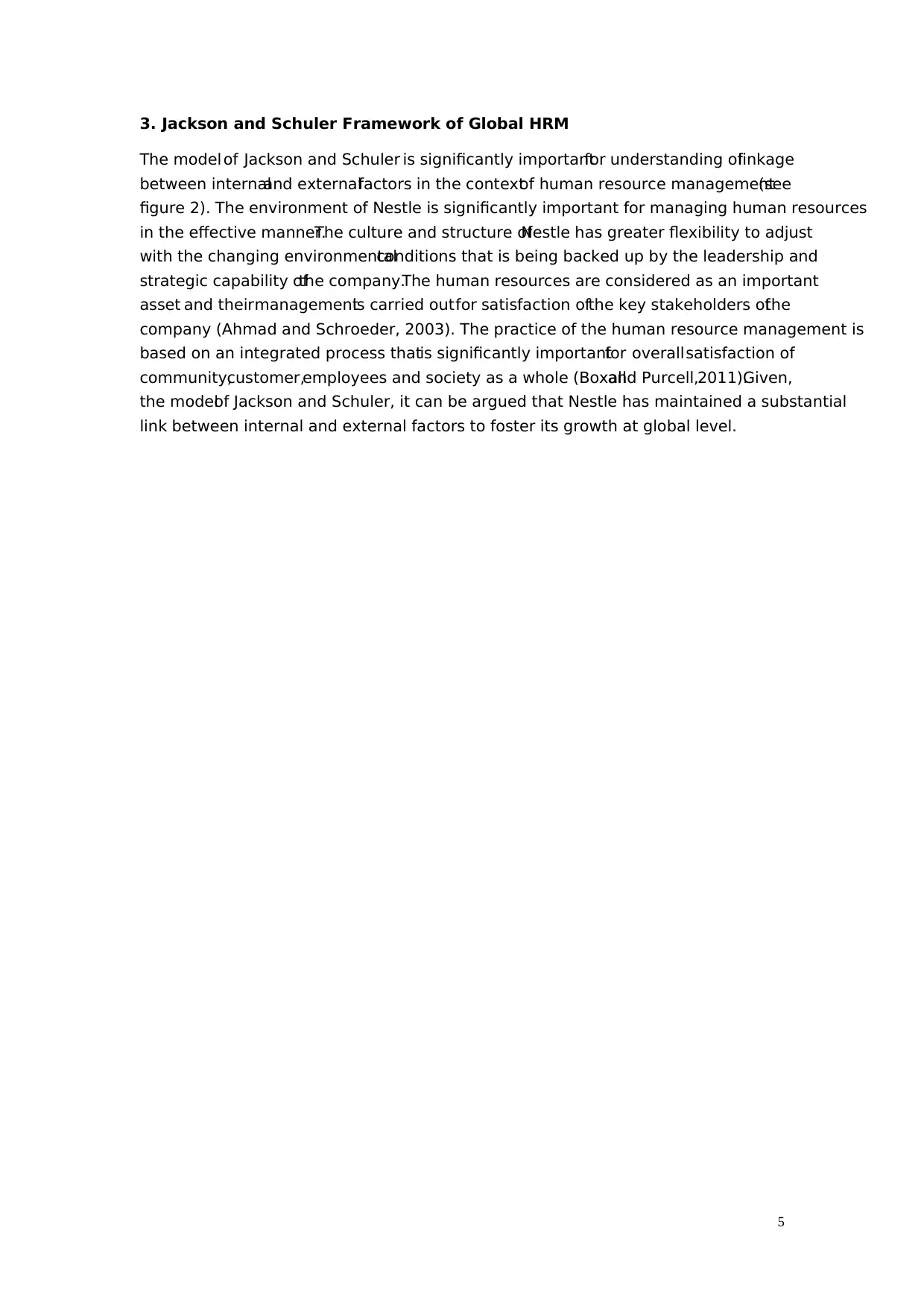
5
3. Jackson and Schuler Framework of Global HRM
The model of Jackson and Schuler is significantly importantfor understanding oflinkage
between internaland externalfactors in the contextof human resource management(see
figure 2). The environment of Nestle is significantly important for managing human resources
in the effective manner.The culture and structure ofNestle has greater flexibility to adjust
with the changing environmentalconditions that is being backed up by the leadership and
strategic capability ofthe company.The human resources are considered as an important
asset and theirmanagementis carried outfor satisfaction ofthe key stakeholders ofthe
company (Ahmad and Schroeder, 2003). The practice of the human resource management is
based on an integrated process thatis significantly importantfor overallsatisfaction of
community,customer,employees and society as a whole (Boxalland Purcell,2011).Given,
the modelof Jackson and Schuler, it can be argued that Nestle has maintained a substantial
link between internal and external factors to foster its growth at global level.
3. Jackson and Schuler Framework of Global HRM
The model of Jackson and Schuler is significantly importantfor understanding oflinkage
between internaland externalfactors in the contextof human resource management(see
figure 2). The environment of Nestle is significantly important for managing human resources
in the effective manner.The culture and structure ofNestle has greater flexibility to adjust
with the changing environmentalconditions that is being backed up by the leadership and
strategic capability ofthe company.The human resources are considered as an important
asset and theirmanagementis carried outfor satisfaction ofthe key stakeholders ofthe
company (Ahmad and Schroeder, 2003). The practice of the human resource management is
based on an integrated process thatis significantly importantfor overallsatisfaction of
community,customer,employees and society as a whole (Boxalland Purcell,2011).Given,
the modelof Jackson and Schuler, it can be argued that Nestle has maintained a substantial
link between internal and external factors to foster its growth at global level.
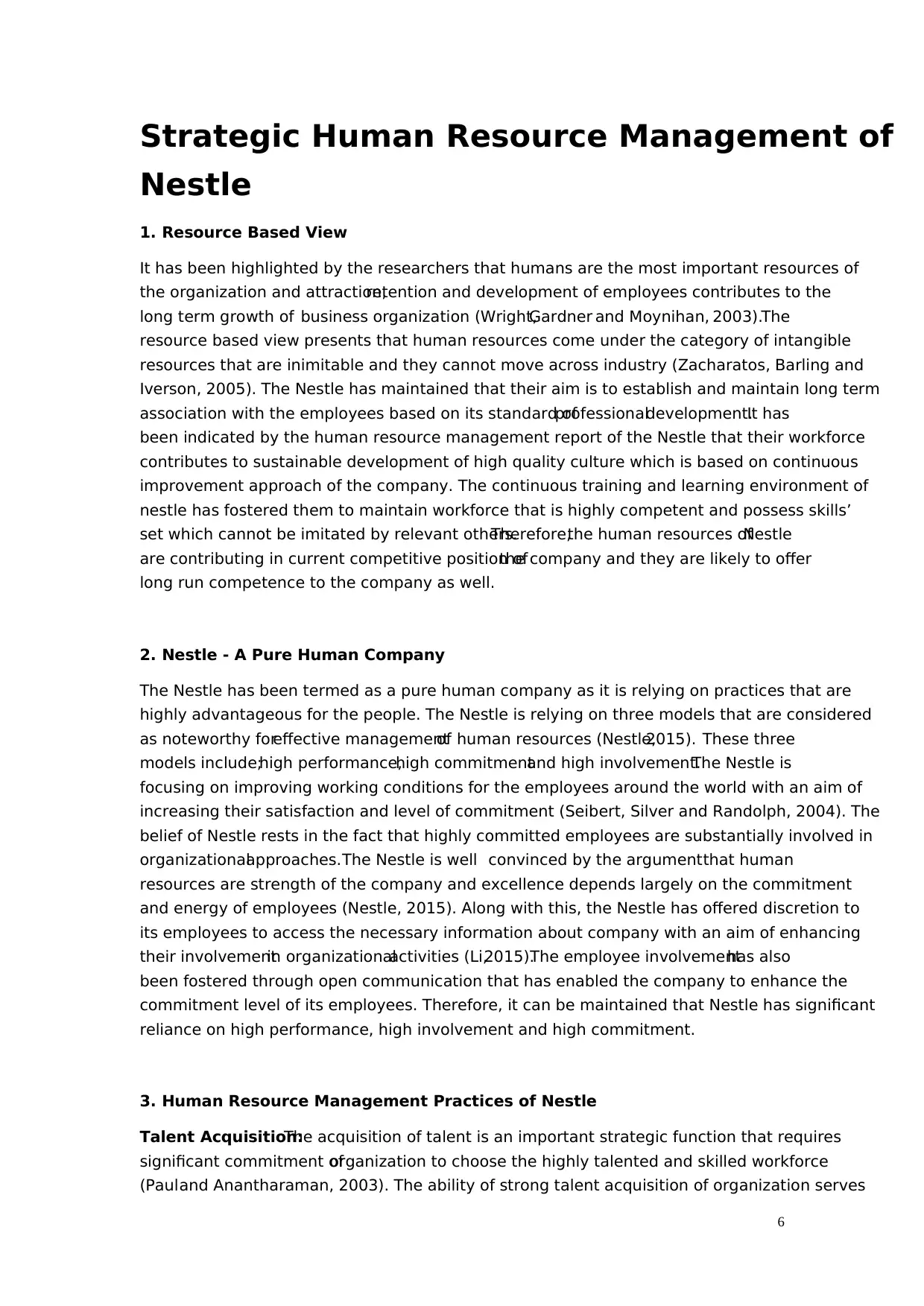
6
Strategic Human Resource Management of
Nestle
1. Resource Based View
It has been highlighted by the researchers that humans are the most important resources of
the organization and attraction,retention and development of employees contributes to the
long term growth of business organization (Wright,Gardner and Moynihan, 2003).The
resource based view presents that human resources come under the category of intangible
resources that are inimitable and they cannot move across industry (Zacharatos, Barling and
Iverson, 2005). The Nestle has maintained that their aim is to establish and maintain long term
association with the employees based on its standard ofprofessionaldevelopment.It has
been indicated by the human resource management report of the Nestle that their workforce
contributes to sustainable development of high quality culture which is based on continuous
improvement approach of the company. The continuous training and learning environment of
nestle has fostered them to maintain workforce that is highly competent and possess skills’
set which cannot be imitated by relevant others.Therefore,the human resources ofNestle
are contributing in current competitive position ofthe company and they are likely to offer
long run competence to the company as well.
2. Nestle - A Pure Human Company
The Nestle has been termed as a pure human company as it is relying on practices that are
highly advantageous for the people. The Nestle is relying on three models that are considered
as noteworthy foreffective managementof human resources (Nestle,2015). These three
models include;high performance,high commitmentand high involvement.The Nestle is
focusing on improving working conditions for the employees around the world with an aim of
increasing their satisfaction and level of commitment (Seibert, Silver and Randolph, 2004). The
belief of Nestle rests in the fact that highly committed employees are substantially involved in
organizationalapproaches.The Nestle is well convinced by the argumentthat human
resources are strength of the company and excellence depends largely on the commitment
and energy of employees (Nestle, 2015). Along with this, the Nestle has offered discretion to
its employees to access the necessary information about company with an aim of enhancing
their involvementin organizationalactivities (Li,2015).The employee involvementhas also
been fostered through open communication that has enabled the company to enhance the
commitment level of its employees. Therefore, it can be maintained that Nestle has significant
reliance on high performance, high involvement and high commitment.
3. Human Resource Management Practices of Nestle
Talent Acquisition:The acquisition of talent is an important strategic function that requires
significant commitment oforganization to choose the highly talented and skilled workforce
(Pauland Anantharaman, 2003). The ability of strong talent acquisition of organization serves
Strategic Human Resource Management of
Nestle
1. Resource Based View
It has been highlighted by the researchers that humans are the most important resources of
the organization and attraction,retention and development of employees contributes to the
long term growth of business organization (Wright,Gardner and Moynihan, 2003).The
resource based view presents that human resources come under the category of intangible
resources that are inimitable and they cannot move across industry (Zacharatos, Barling and
Iverson, 2005). The Nestle has maintained that their aim is to establish and maintain long term
association with the employees based on its standard ofprofessionaldevelopment.It has
been indicated by the human resource management report of the Nestle that their workforce
contributes to sustainable development of high quality culture which is based on continuous
improvement approach of the company. The continuous training and learning environment of
nestle has fostered them to maintain workforce that is highly competent and possess skills’
set which cannot be imitated by relevant others.Therefore,the human resources ofNestle
are contributing in current competitive position ofthe company and they are likely to offer
long run competence to the company as well.
2. Nestle - A Pure Human Company
The Nestle has been termed as a pure human company as it is relying on practices that are
highly advantageous for the people. The Nestle is relying on three models that are considered
as noteworthy foreffective managementof human resources (Nestle,2015). These three
models include;high performance,high commitmentand high involvement.The Nestle is
focusing on improving working conditions for the employees around the world with an aim of
increasing their satisfaction and level of commitment (Seibert, Silver and Randolph, 2004). The
belief of Nestle rests in the fact that highly committed employees are substantially involved in
organizationalapproaches.The Nestle is well convinced by the argumentthat human
resources are strength of the company and excellence depends largely on the commitment
and energy of employees (Nestle, 2015). Along with this, the Nestle has offered discretion to
its employees to access the necessary information about company with an aim of enhancing
their involvementin organizationalactivities (Li,2015).The employee involvementhas also
been fostered through open communication that has enabled the company to enhance the
commitment level of its employees. Therefore, it can be maintained that Nestle has significant
reliance on high performance, high involvement and high commitment.
3. Human Resource Management Practices of Nestle
Talent Acquisition:The acquisition of talent is an important strategic function that requires
significant commitment oforganization to choose the highly talented and skilled workforce
(Pauland Anantharaman, 2003). The ability of strong talent acquisition of organization serves
⊘ This is a preview!⊘
Do you want full access?
Subscribe today to unlock all pages.

Trusted by 1+ million students worldwide
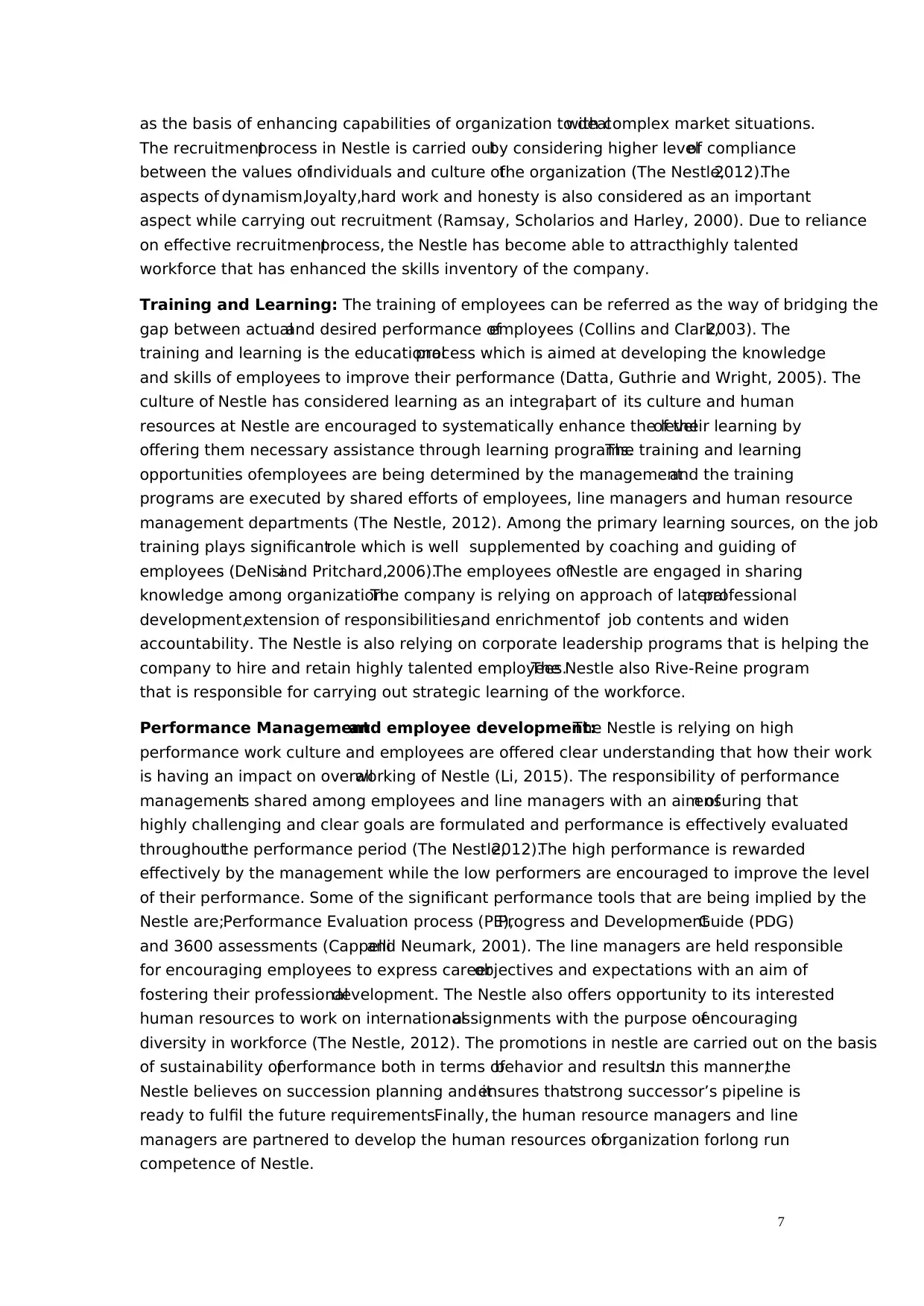
7
as the basis of enhancing capabilities of organization to dealwith complex market situations.
The recruitmentprocess in Nestle is carried outby considering higher levelof compliance
between the values ofindividuals and culture ofthe organization (The Nestle,2012).The
aspects of dynamism,loyalty,hard work and honesty is also considered as an important
aspect while carrying out recruitment (Ramsay, Scholarios and Harley, 2000). Due to reliance
on effective recruitmentprocess, the Nestle has become able to attracthighly talented
workforce that has enhanced the skills inventory of the company.
Training and Learning: The training of employees can be referred as the way of bridging the
gap between actualand desired performance ofemployees (Collins and Clark,2003). The
training and learning is the educationalprocess which is aimed at developing the knowledge
and skills of employees to improve their performance (Datta, Guthrie and Wright, 2005). The
culture of Nestle has considered learning as an integralpart of its culture and human
resources at Nestle are encouraged to systematically enhance the levelof their learning by
offering them necessary assistance through learning programs.The training and learning
opportunities ofemployees are being determined by the managementand the training
programs are executed by shared efforts of employees, line managers and human resource
management departments (The Nestle, 2012). Among the primary learning sources, on the job
training plays significantrole which is well supplemented by coaching and guiding of
employees (DeNisiand Pritchard,2006).The employees ofNestle are engaged in sharing
knowledge among organization.The company is relying on approach of lateralprofessional
development,extension of responsibilities,and enrichmentof job contents and widen
accountability. The Nestle is also relying on corporate leadership programs that is helping the
company to hire and retain highly talented employees.The Nestle also Rive-Reine program
that is responsible for carrying out strategic learning of the workforce.
Performance Managementand employee development:The Nestle is relying on high
performance work culture and employees are offered clear understanding that how their work
is having an impact on overallworking of Nestle (Li, 2015). The responsibility of performance
managementis shared among employees and line managers with an aim ofensuring that
highly challenging and clear goals are formulated and performance is effectively evaluated
throughoutthe performance period (The Nestle,2012).The high performance is rewarded
effectively by the management while the low performers are encouraged to improve the level
of their performance. Some of the significant performance tools that are being implied by the
Nestle are;Performance Evaluation process (PE),Progress and DevelopmentGuide (PDG)
and 3600 assessments (Cappelliand Neumark, 2001). The line managers are held responsible
for encouraging employees to express careerobjectives and expectations with an aim of
fostering their professionaldevelopment. The Nestle also offers opportunity to its interested
human resources to work on internationalassignments with the purpose ofencouraging
diversity in workforce (The Nestle, 2012). The promotions in nestle are carried out on the basis
of sustainability ofperformance both in terms ofbehavior and results.In this manner,the
Nestle believes on succession planning and itensures thatstrong successor’s pipeline is
ready to fulfil the future requirements.Finally, the human resource managers and line
managers are partnered to develop the human resources oforganization forlong run
competence of Nestle.
as the basis of enhancing capabilities of organization to dealwith complex market situations.
The recruitmentprocess in Nestle is carried outby considering higher levelof compliance
between the values ofindividuals and culture ofthe organization (The Nestle,2012).The
aspects of dynamism,loyalty,hard work and honesty is also considered as an important
aspect while carrying out recruitment (Ramsay, Scholarios and Harley, 2000). Due to reliance
on effective recruitmentprocess, the Nestle has become able to attracthighly talented
workforce that has enhanced the skills inventory of the company.
Training and Learning: The training of employees can be referred as the way of bridging the
gap between actualand desired performance ofemployees (Collins and Clark,2003). The
training and learning is the educationalprocess which is aimed at developing the knowledge
and skills of employees to improve their performance (Datta, Guthrie and Wright, 2005). The
culture of Nestle has considered learning as an integralpart of its culture and human
resources at Nestle are encouraged to systematically enhance the levelof their learning by
offering them necessary assistance through learning programs.The training and learning
opportunities ofemployees are being determined by the managementand the training
programs are executed by shared efforts of employees, line managers and human resource
management departments (The Nestle, 2012). Among the primary learning sources, on the job
training plays significantrole which is well supplemented by coaching and guiding of
employees (DeNisiand Pritchard,2006).The employees ofNestle are engaged in sharing
knowledge among organization.The company is relying on approach of lateralprofessional
development,extension of responsibilities,and enrichmentof job contents and widen
accountability. The Nestle is also relying on corporate leadership programs that is helping the
company to hire and retain highly talented employees.The Nestle also Rive-Reine program
that is responsible for carrying out strategic learning of the workforce.
Performance Managementand employee development:The Nestle is relying on high
performance work culture and employees are offered clear understanding that how their work
is having an impact on overallworking of Nestle (Li, 2015). The responsibility of performance
managementis shared among employees and line managers with an aim ofensuring that
highly challenging and clear goals are formulated and performance is effectively evaluated
throughoutthe performance period (The Nestle,2012).The high performance is rewarded
effectively by the management while the low performers are encouraged to improve the level
of their performance. Some of the significant performance tools that are being implied by the
Nestle are;Performance Evaluation process (PE),Progress and DevelopmentGuide (PDG)
and 3600 assessments (Cappelliand Neumark, 2001). The line managers are held responsible
for encouraging employees to express careerobjectives and expectations with an aim of
fostering their professionaldevelopment. The Nestle also offers opportunity to its interested
human resources to work on internationalassignments with the purpose ofencouraging
diversity in workforce (The Nestle, 2012). The promotions in nestle are carried out on the basis
of sustainability ofperformance both in terms ofbehavior and results.In this manner,the
Nestle believes on succession planning and itensures thatstrong successor’s pipeline is
ready to fulfil the future requirements.Finally, the human resource managers and line
managers are partnered to develop the human resources oforganization forlong run
competence of Nestle.
Paraphrase This Document
Need a fresh take? Get an instant paraphrase of this document with our AI Paraphraser
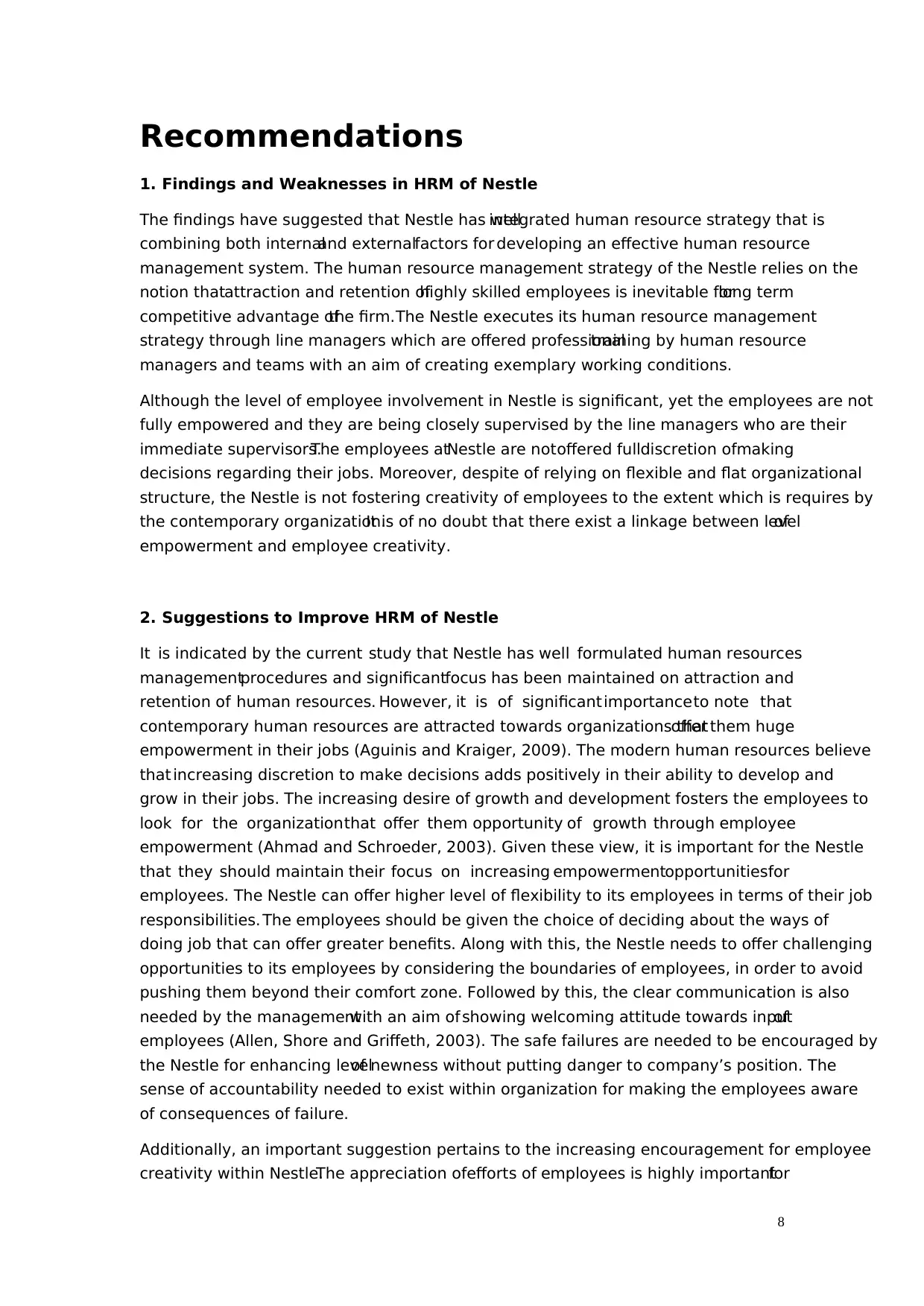
8
Recommendations
1. Findings and Weaknesses in HRM of Nestle
The findings have suggested that Nestle has wellintegrated human resource strategy that is
combining both internaland externalfactors for developing an effective human resource
management system. The human resource management strategy of the Nestle relies on the
notion thatattraction and retention ofhighly skilled employees is inevitable forlong term
competitive advantage ofthe firm.The Nestle executes its human resource management
strategy through line managers which are offered professionaltraining by human resource
managers and teams with an aim of creating exemplary working conditions.
Although the level of employee involvement in Nestle is significant, yet the employees are not
fully empowered and they are being closely supervised by the line managers who are their
immediate supervisors.The employees atNestle are notoffered fulldiscretion ofmaking
decisions regarding their jobs. Moreover, despite of relying on flexible and flat organizational
structure, the Nestle is not fostering creativity of employees to the extent which is requires by
the contemporary organization.It is of no doubt that there exist a linkage between levelof
empowerment and employee creativity.
2. Suggestions to Improve HRM of Nestle
It is indicated by the current study that Nestle has well formulated human resources
managementprocedures and significantfocus has been maintained on attraction and
retention of human resources. However, it is of significant importanceto note that
contemporary human resources are attracted towards organizations thatoffer them huge
empowerment in their jobs (Aguinis and Kraiger, 2009). The modern human resources believe
that increasing discretion to make decisions adds positively in their ability to develop and
grow in their jobs. The increasing desire of growth and development fosters the employees to
look for the organizationthat offer them opportunity of growth through employee
empowerment (Ahmad and Schroeder, 2003). Given these view, it is important for the Nestle
that they should maintain their focus on increasing empowermentopportunitiesfor
employees. The Nestle can offer higher level of flexibility to its employees in terms of their job
responsibilities. The employees should be given the choice of deciding about the ways of
doing job that can offer greater benefits. Along with this, the Nestle needs to offer challenging
opportunities to its employees by considering the boundaries of employees, in order to avoid
pushing them beyond their comfort zone. Followed by this, the clear communication is also
needed by the managementwith an aim of showing welcoming attitude towards inputof
employees (Allen, Shore and Griffeth, 2003). The safe failures are needed to be encouraged by
the Nestle for enhancing levelof newness without putting danger to company’s position. The
sense of accountability needed to exist within organization for making the employees aware
of consequences of failure.
Additionally, an important suggestion pertains to the increasing encouragement for employee
creativity within Nestle.The appreciation ofefforts of employees is highly importantfor
Recommendations
1. Findings and Weaknesses in HRM of Nestle
The findings have suggested that Nestle has wellintegrated human resource strategy that is
combining both internaland externalfactors for developing an effective human resource
management system. The human resource management strategy of the Nestle relies on the
notion thatattraction and retention ofhighly skilled employees is inevitable forlong term
competitive advantage ofthe firm.The Nestle executes its human resource management
strategy through line managers which are offered professionaltraining by human resource
managers and teams with an aim of creating exemplary working conditions.
Although the level of employee involvement in Nestle is significant, yet the employees are not
fully empowered and they are being closely supervised by the line managers who are their
immediate supervisors.The employees atNestle are notoffered fulldiscretion ofmaking
decisions regarding their jobs. Moreover, despite of relying on flexible and flat organizational
structure, the Nestle is not fostering creativity of employees to the extent which is requires by
the contemporary organization.It is of no doubt that there exist a linkage between levelof
empowerment and employee creativity.
2. Suggestions to Improve HRM of Nestle
It is indicated by the current study that Nestle has well formulated human resources
managementprocedures and significantfocus has been maintained on attraction and
retention of human resources. However, it is of significant importanceto note that
contemporary human resources are attracted towards organizations thatoffer them huge
empowerment in their jobs (Aguinis and Kraiger, 2009). The modern human resources believe
that increasing discretion to make decisions adds positively in their ability to develop and
grow in their jobs. The increasing desire of growth and development fosters the employees to
look for the organizationthat offer them opportunity of growth through employee
empowerment (Ahmad and Schroeder, 2003). Given these view, it is important for the Nestle
that they should maintain their focus on increasing empowermentopportunitiesfor
employees. The Nestle can offer higher level of flexibility to its employees in terms of their job
responsibilities. The employees should be given the choice of deciding about the ways of
doing job that can offer greater benefits. Along with this, the Nestle needs to offer challenging
opportunities to its employees by considering the boundaries of employees, in order to avoid
pushing them beyond their comfort zone. Followed by this, the clear communication is also
needed by the managementwith an aim of showing welcoming attitude towards inputof
employees (Allen, Shore and Griffeth, 2003). The safe failures are needed to be encouraged by
the Nestle for enhancing levelof newness without putting danger to company’s position. The
sense of accountability needed to exist within organization for making the employees aware
of consequences of failure.
Additionally, an important suggestion pertains to the increasing encouragement for employee
creativity within Nestle.The appreciation ofefforts of employees is highly importantfor
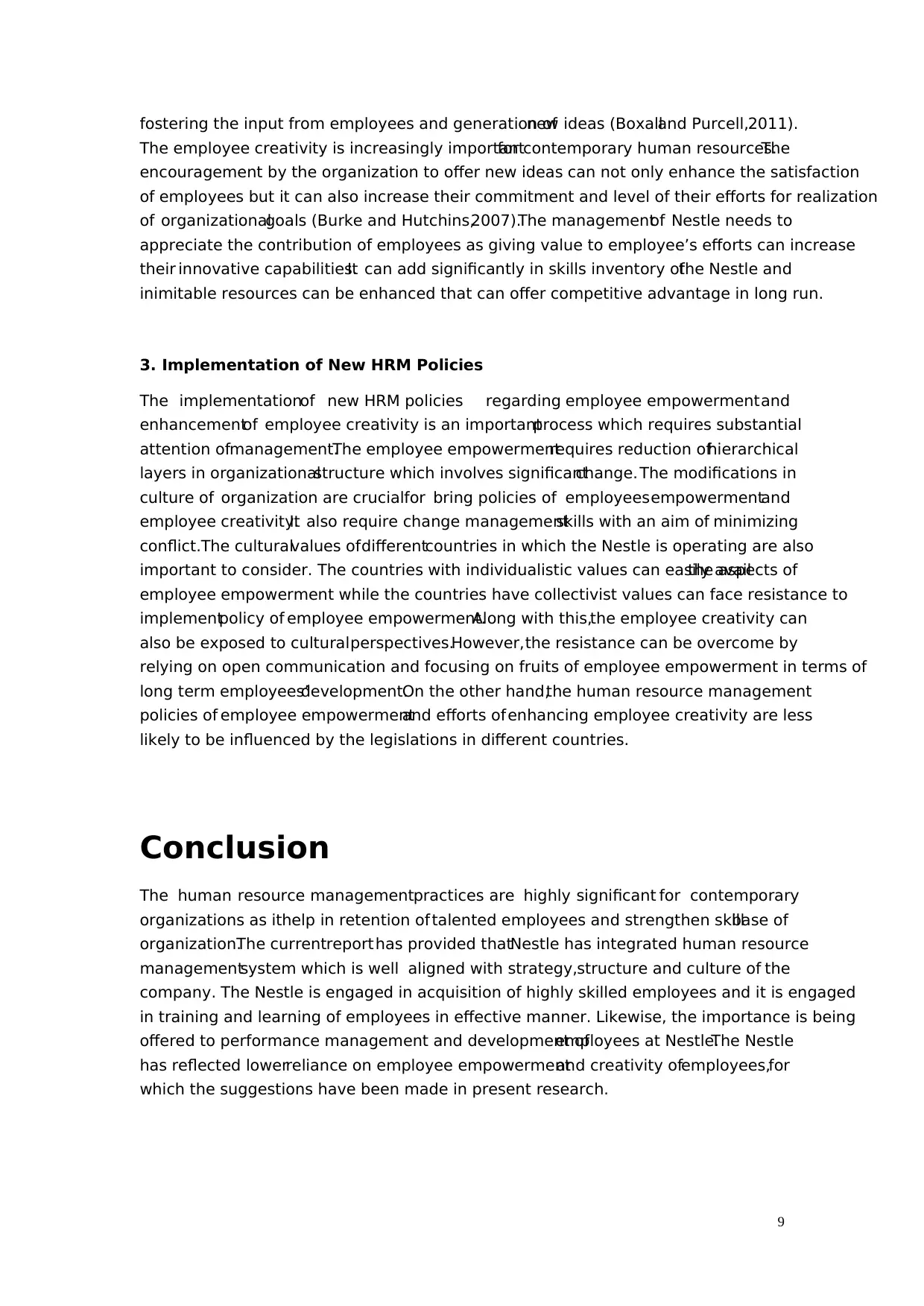
9
fostering the input from employees and generation ofnew ideas (Boxalland Purcell,2011).
The employee creativity is increasingly importantfor contemporary human resources.The
encouragement by the organization to offer new ideas can not only enhance the satisfaction
of employees but it can also increase their commitment and level of their efforts for realization
of organizationalgoals (Burke and Hutchins,2007).The managementof Nestle needs to
appreciate the contribution of employees as giving value to employee’s efforts can increase
their innovative capabilities.It can add significantly in skills inventory ofthe Nestle and
inimitable resources can be enhanced that can offer competitive advantage in long run.
3. Implementation of New HRM Policies
The implementationof new HRM policies regarding employee empowermentand
enhancementof employee creativity is an importantprocess which requires substantial
attention ofmanagement.The employee empowermentrequires reduction ofhierarchical
layers in organizationalstructure which involves significantchange. The modifications in
culture of organization are crucialfor bring policies of employeesempowermentand
employee creativity.It also require change managementskills with an aim of minimizing
conflict.The culturalvalues ofdifferentcountries in which the Nestle is operating are also
important to consider. The countries with individualistic values can easily availthe aspects of
employee empowerment while the countries have collectivist values can face resistance to
implementpolicy of employee empowerment.Along with this,the employee creativity can
also be exposed to culturalperspectives.However,the resistance can be overcome by
relying on open communication and focusing on fruits of employee empowerment in terms of
long term employees’development.On the other hand,the human resource management
policies of employee empowermentand efforts ofenhancing employee creativity are less
likely to be influenced by the legislations in different countries.
Conclusion
The human resource managementpractices are highly significant for contemporary
organizations as ithelp in retention of talented employees and strengthen skillbase of
organization.The currentreport has provided thatNestle has integrated human resource
managementsystem which is well aligned with strategy,structure and culture of the
company. The Nestle is engaged in acquisition of highly skilled employees and it is engaged
in training and learning of employees in effective manner. Likewise, the importance is being
offered to performance management and development ofemployees at Nestle.The Nestle
has reflected lowerreliance on employee empowermentand creativity ofemployees,for
which the suggestions have been made in present research.
fostering the input from employees and generation ofnew ideas (Boxalland Purcell,2011).
The employee creativity is increasingly importantfor contemporary human resources.The
encouragement by the organization to offer new ideas can not only enhance the satisfaction
of employees but it can also increase their commitment and level of their efforts for realization
of organizationalgoals (Burke and Hutchins,2007).The managementof Nestle needs to
appreciate the contribution of employees as giving value to employee’s efforts can increase
their innovative capabilities.It can add significantly in skills inventory ofthe Nestle and
inimitable resources can be enhanced that can offer competitive advantage in long run.
3. Implementation of New HRM Policies
The implementationof new HRM policies regarding employee empowermentand
enhancementof employee creativity is an importantprocess which requires substantial
attention ofmanagement.The employee empowermentrequires reduction ofhierarchical
layers in organizationalstructure which involves significantchange. The modifications in
culture of organization are crucialfor bring policies of employeesempowermentand
employee creativity.It also require change managementskills with an aim of minimizing
conflict.The culturalvalues ofdifferentcountries in which the Nestle is operating are also
important to consider. The countries with individualistic values can easily availthe aspects of
employee empowerment while the countries have collectivist values can face resistance to
implementpolicy of employee empowerment.Along with this,the employee creativity can
also be exposed to culturalperspectives.However,the resistance can be overcome by
relying on open communication and focusing on fruits of employee empowerment in terms of
long term employees’development.On the other hand,the human resource management
policies of employee empowermentand efforts ofenhancing employee creativity are less
likely to be influenced by the legislations in different countries.
Conclusion
The human resource managementpractices are highly significant for contemporary
organizations as ithelp in retention of talented employees and strengthen skillbase of
organization.The currentreport has provided thatNestle has integrated human resource
managementsystem which is well aligned with strategy,structure and culture of the
company. The Nestle is engaged in acquisition of highly skilled employees and it is engaged
in training and learning of employees in effective manner. Likewise, the importance is being
offered to performance management and development ofemployees at Nestle.The Nestle
has reflected lowerreliance on employee empowermentand creativity ofemployees,for
which the suggestions have been made in present research.
⊘ This is a preview!⊘
Do you want full access?
Subscribe today to unlock all pages.

Trusted by 1+ million students worldwide
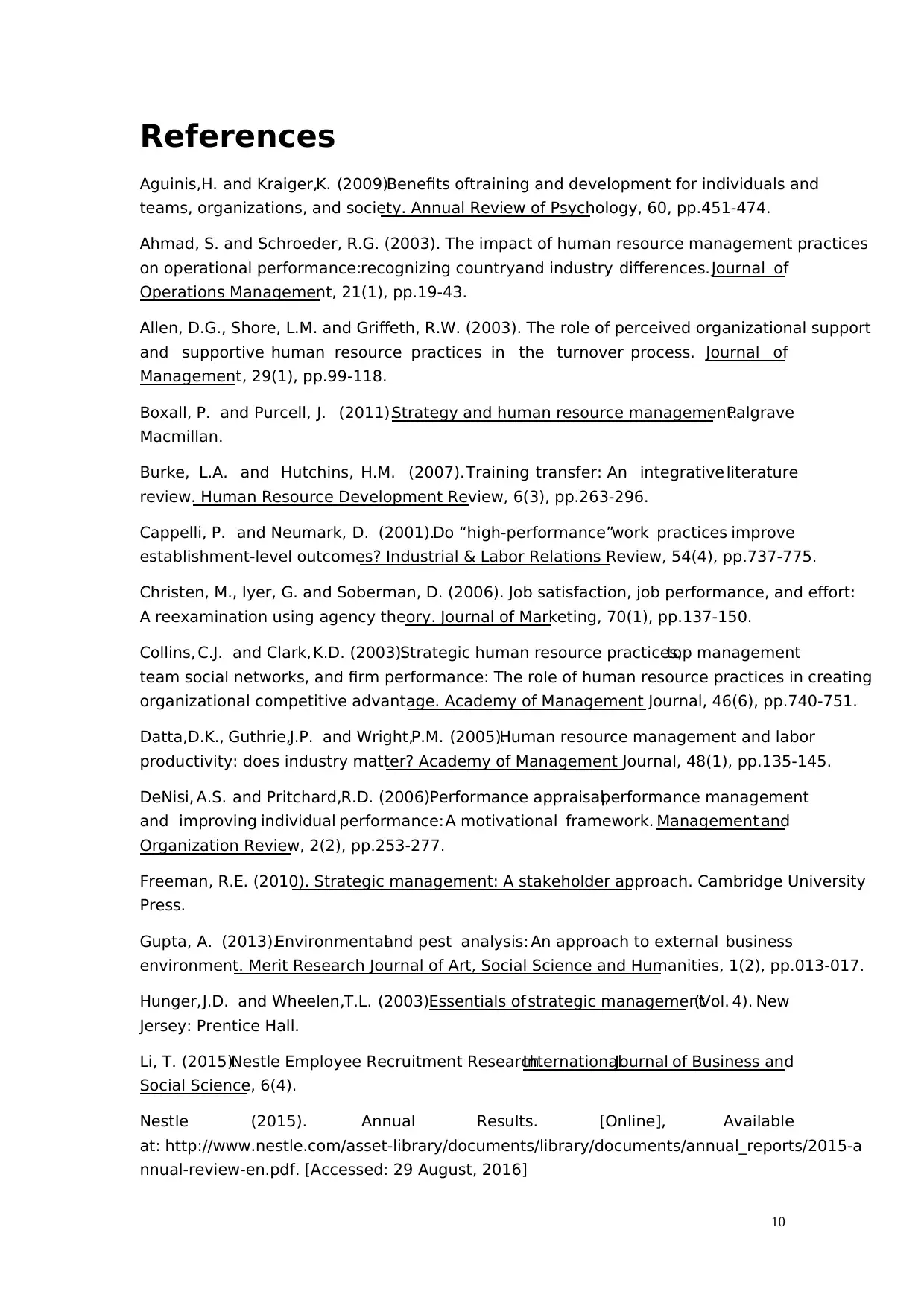
10
References
Aguinis,H. and Kraiger,K. (2009).Benefits oftraining and development for individuals and
teams, organizations, and society. Annual Review of Psychology, 60, pp.451-474.
Ahmad, S. and Schroeder, R.G. (2003). The impact of human resource management practices
on operational performance:recognizing countryand industry differences.Journal of
Operations Management, 21(1), pp.19-43.
Allen, D.G., Shore, L.M. and Griffeth, R.W. (2003). The role of perceived organizational support
and supportive human resource practices in the turnover process. Journal of
Management, 29(1), pp.99-118.
Boxall, P. and Purcell, J. (2011).Strategy and human resource management.Palgrave
Macmillan.
Burke, L.A. and Hutchins, H.M. (2007).Training transfer: An integrative literature
review. Human Resource Development Review, 6(3), pp.263-296.
Cappelli, P. and Neumark, D. (2001).Do “high-performance”work practices improve
establishment-level outcomes? Industrial & Labor Relations Review, 54(4), pp.737-775.
Christen, M., Iyer, G. and Soberman, D. (2006). Job satisfaction, job performance, and effort:
A reexamination using agency theory. Journal of Marketing, 70(1), pp.137-150.
Collins, C.J. and Clark, K.D. (2003).Strategic human resource practices,top management
team social networks, and firm performance: The role of human resource practices in creating
organizational competitive advantage. Academy of Management Journal, 46(6), pp.740-751.
Datta,D.K., Guthrie,J.P. and Wright,P.M. (2005).Human resource management and labor
productivity: does industry matter? Academy of Management Journal, 48(1), pp.135-145.
DeNisi, A.S. and Pritchard,R.D. (2006).Performance appraisal,performance management
and improving individual performance:A motivational framework. Management and
Organization Review, 2(2), pp.253-277.
Freeman, R.E. (2010). Strategic management: A stakeholder approach. Cambridge University
Press.
Gupta, A. (2013).Environmentaland pest analysis: An approach to external business
environment. Merit Research Journal of Art, Social Science and Humanities, 1(2), pp.013-017.
Hunger,J.D. and Wheelen,T.L. (2003).Essentials of strategic management(Vol. 4). New
Jersey: Prentice Hall.
Li, T. (2015).Nestle Employee Recruitment Research.InternationalJournal of Business and
Social Science, 6(4).
Nestle (2015). Annual Results. [Online], Available
at: http://www.nestle.com/asset-library/documents/library/documents/annual_reports/2015-a
nnual-review-en.pdf. [Accessed: 29 August, 2016]
References
Aguinis,H. and Kraiger,K. (2009).Benefits oftraining and development for individuals and
teams, organizations, and society. Annual Review of Psychology, 60, pp.451-474.
Ahmad, S. and Schroeder, R.G. (2003). The impact of human resource management practices
on operational performance:recognizing countryand industry differences.Journal of
Operations Management, 21(1), pp.19-43.
Allen, D.G., Shore, L.M. and Griffeth, R.W. (2003). The role of perceived organizational support
and supportive human resource practices in the turnover process. Journal of
Management, 29(1), pp.99-118.
Boxall, P. and Purcell, J. (2011).Strategy and human resource management.Palgrave
Macmillan.
Burke, L.A. and Hutchins, H.M. (2007).Training transfer: An integrative literature
review. Human Resource Development Review, 6(3), pp.263-296.
Cappelli, P. and Neumark, D. (2001).Do “high-performance”work practices improve
establishment-level outcomes? Industrial & Labor Relations Review, 54(4), pp.737-775.
Christen, M., Iyer, G. and Soberman, D. (2006). Job satisfaction, job performance, and effort:
A reexamination using agency theory. Journal of Marketing, 70(1), pp.137-150.
Collins, C.J. and Clark, K.D. (2003).Strategic human resource practices,top management
team social networks, and firm performance: The role of human resource practices in creating
organizational competitive advantage. Academy of Management Journal, 46(6), pp.740-751.
Datta,D.K., Guthrie,J.P. and Wright,P.M. (2005).Human resource management and labor
productivity: does industry matter? Academy of Management Journal, 48(1), pp.135-145.
DeNisi, A.S. and Pritchard,R.D. (2006).Performance appraisal,performance management
and improving individual performance:A motivational framework. Management and
Organization Review, 2(2), pp.253-277.
Freeman, R.E. (2010). Strategic management: A stakeholder approach. Cambridge University
Press.
Gupta, A. (2013).Environmentaland pest analysis: An approach to external business
environment. Merit Research Journal of Art, Social Science and Humanities, 1(2), pp.013-017.
Hunger,J.D. and Wheelen,T.L. (2003).Essentials of strategic management(Vol. 4). New
Jersey: Prentice Hall.
Li, T. (2015).Nestle Employee Recruitment Research.InternationalJournal of Business and
Social Science, 6(4).
Nestle (2015). Annual Results. [Online], Available
at: http://www.nestle.com/asset-library/documents/library/documents/annual_reports/2015-a
nnual-review-en.pdf. [Accessed: 29 August, 2016]
Paraphrase This Document
Need a fresh take? Get an instant paraphrase of this document with our AI Paraphraser
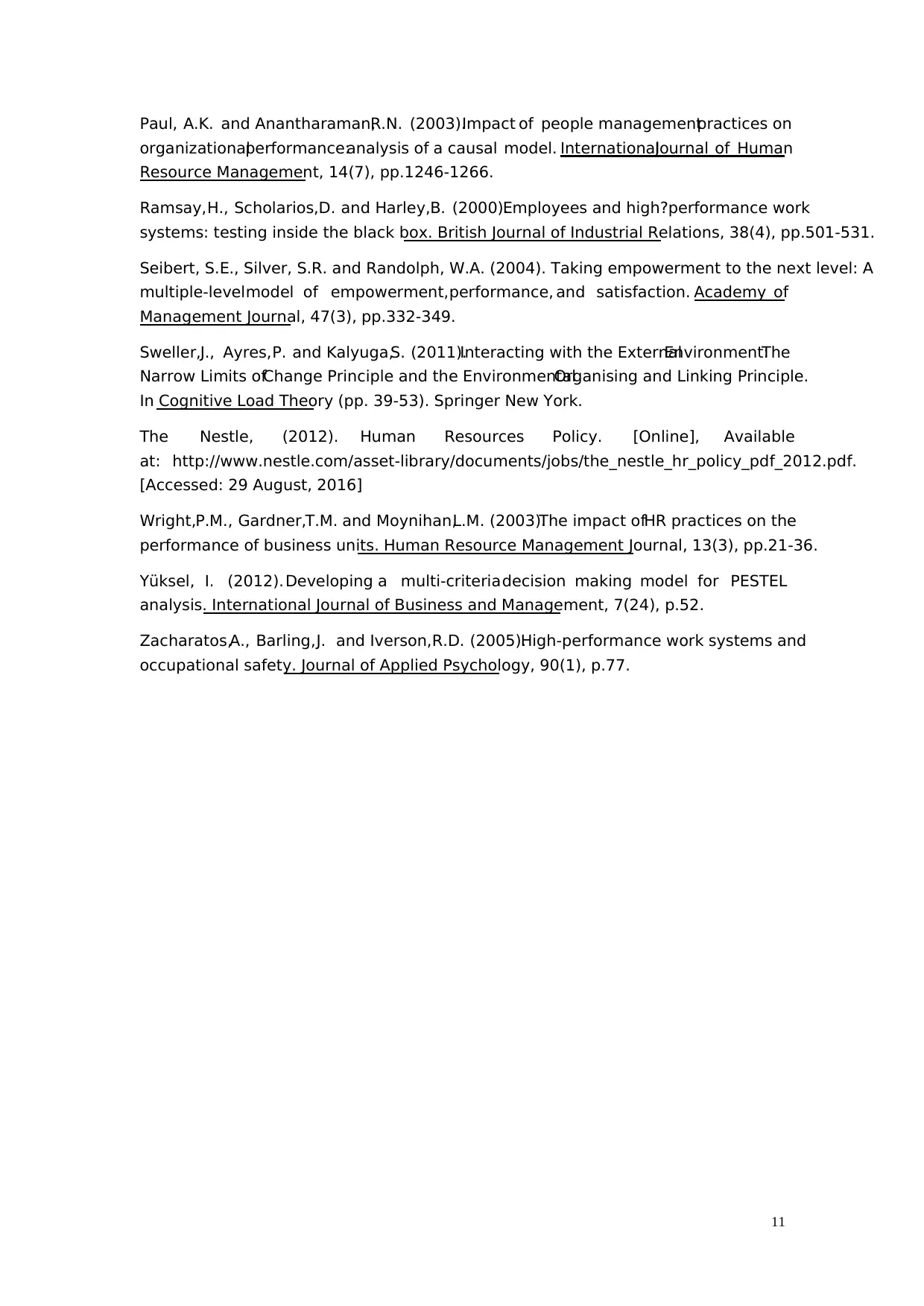
11
Paul, A.K. and Anantharaman,R.N. (2003).Impact of people managementpractices on
organizationalperformance:analysis of a causal model. InternationalJournal of Human
Resource Management, 14(7), pp.1246-1266.
Ramsay,H., Scholarios,D. and Harley,B. (2000).Employees and high?performance work
systems: testing inside the black box. British Journal of Industrial Relations, 38(4), pp.501-531.
Seibert, S.E., Silver, S.R. and Randolph, W.A. (2004). Taking empowerment to the next level: A
multiple-levelmodel of empowerment,performance, and satisfaction. Academy of
Management Journal, 47(3), pp.332-349.
Sweller,J., Ayres,P. and Kalyuga,S. (2011).Interacting with the ExternalEnvironment:The
Narrow Limits ofChange Principle and the EnvironmentalOrganising and Linking Principle.
In Cognitive Load Theory (pp. 39-53). Springer New York.
The Nestle, (2012). Human Resources Policy. [Online], Available
at: http://www.nestle.com/asset-library/documents/jobs/the_nestle_hr_policy_pdf_2012.pdf.
[Accessed: 29 August, 2016]
Wright,P.M., Gardner,T.M. and Moynihan,L.M. (2003).The impact ofHR practices on the
performance of business units. Human Resource Management Journal, 13(3), pp.21-36.
Yüksel, I. (2012). Developing a multi-criteriadecision making model for PESTEL
analysis. International Journal of Business and Management, 7(24), p.52.
Zacharatos,A., Barling,J. and Iverson,R.D. (2005).High-performance work systems and
occupational safety. Journal of Applied Psychology, 90(1), p.77.
Paul, A.K. and Anantharaman,R.N. (2003).Impact of people managementpractices on
organizationalperformance:analysis of a causal model. InternationalJournal of Human
Resource Management, 14(7), pp.1246-1266.
Ramsay,H., Scholarios,D. and Harley,B. (2000).Employees and high?performance work
systems: testing inside the black box. British Journal of Industrial Relations, 38(4), pp.501-531.
Seibert, S.E., Silver, S.R. and Randolph, W.A. (2004). Taking empowerment to the next level: A
multiple-levelmodel of empowerment,performance, and satisfaction. Academy of
Management Journal, 47(3), pp.332-349.
Sweller,J., Ayres,P. and Kalyuga,S. (2011).Interacting with the ExternalEnvironment:The
Narrow Limits ofChange Principle and the EnvironmentalOrganising and Linking Principle.
In Cognitive Load Theory (pp. 39-53). Springer New York.
The Nestle, (2012). Human Resources Policy. [Online], Available
at: http://www.nestle.com/asset-library/documents/jobs/the_nestle_hr_policy_pdf_2012.pdf.
[Accessed: 29 August, 2016]
Wright,P.M., Gardner,T.M. and Moynihan,L.M. (2003).The impact ofHR practices on the
performance of business units. Human Resource Management Journal, 13(3), pp.21-36.
Yüksel, I. (2012). Developing a multi-criteriadecision making model for PESTEL
analysis. International Journal of Business and Management, 7(24), p.52.
Zacharatos,A., Barling,J. and Iverson,R.D. (2005).High-performance work systems and
occupational safety. Journal of Applied Psychology, 90(1), p.77.
1 out of 11
Related Documents
Your All-in-One AI-Powered Toolkit for Academic Success.
+13062052269
info@desklib.com
Available 24*7 on WhatsApp / Email
![[object Object]](/_next/static/media/star-bottom.7253800d.svg)
Unlock your academic potential
Copyright © 2020–2025 A2Z Services. All Rights Reserved. Developed and managed by ZUCOL.





